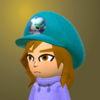Also, while messing around with that, found an undocumented attribute for tiles:
Bit 7 (i.e. 128) is reverse video. It forces the tile color to black (respecting alpha), and uses the color set for that tile as the background color.
ATTR won't allow you to set it (it gives an Out of range error), but you can set it with TLOAD, TARRAY, and probably other commands.
EDIT: "Forces to black" isn't quite right. It only looks like that in front of a black background. Basically, wherever the font is opaque, it makes the tile transparent there, and vice versa. See below for screenshots that make it much clearer what's going on.
Hmm, so it's like the trick in SB3 where you set the text foreground to transparent and the text background to black. The text screen is basically stenciled by the text characters. IIRC this was faster to make custom text coloring than GPUTCHR was.
The inverse bit seems to be illegal for sprite attributes (Out of range.) If there is one for sprites I can't find it.
It is illegal to use the text inverse bit on ATTR TPUT TFILL so the only legitimate way to use it is with TLOAD or a TARRAY/TUPDATE.
This seems like a useful feature even if it is weird and smileboom should try to make it more accessible.
So does it invert all the channels? or something more complex?
Are you sure it's not
R = (1-font R) * Tile R etc.?
What do all of the function keys do?
Is there an easy way to load GRP's from SB3 to SB4? I transferred the file over but I can't just use GLOAD.
Does anyone have a USB mouse that actually works with SB4? Can you read the wheel and tell me what the output looks like?
Mine outputted a number that increased and decreased as I scrolled the mouse wheel up and down. It only seemed to output multiples of 120.
Damn, too bad I'll never get a Switch until Nintendo eventually discontinues it or so...
Has anyone messed around with the IRsensor shooting mode? I’m trying to set something up like the Wii controller where a sprite moves across the screen depending on where you’re pointing a controller. Should I be looking more into the gyroscope or do you think the IRsensor is the right way to pull it off?


